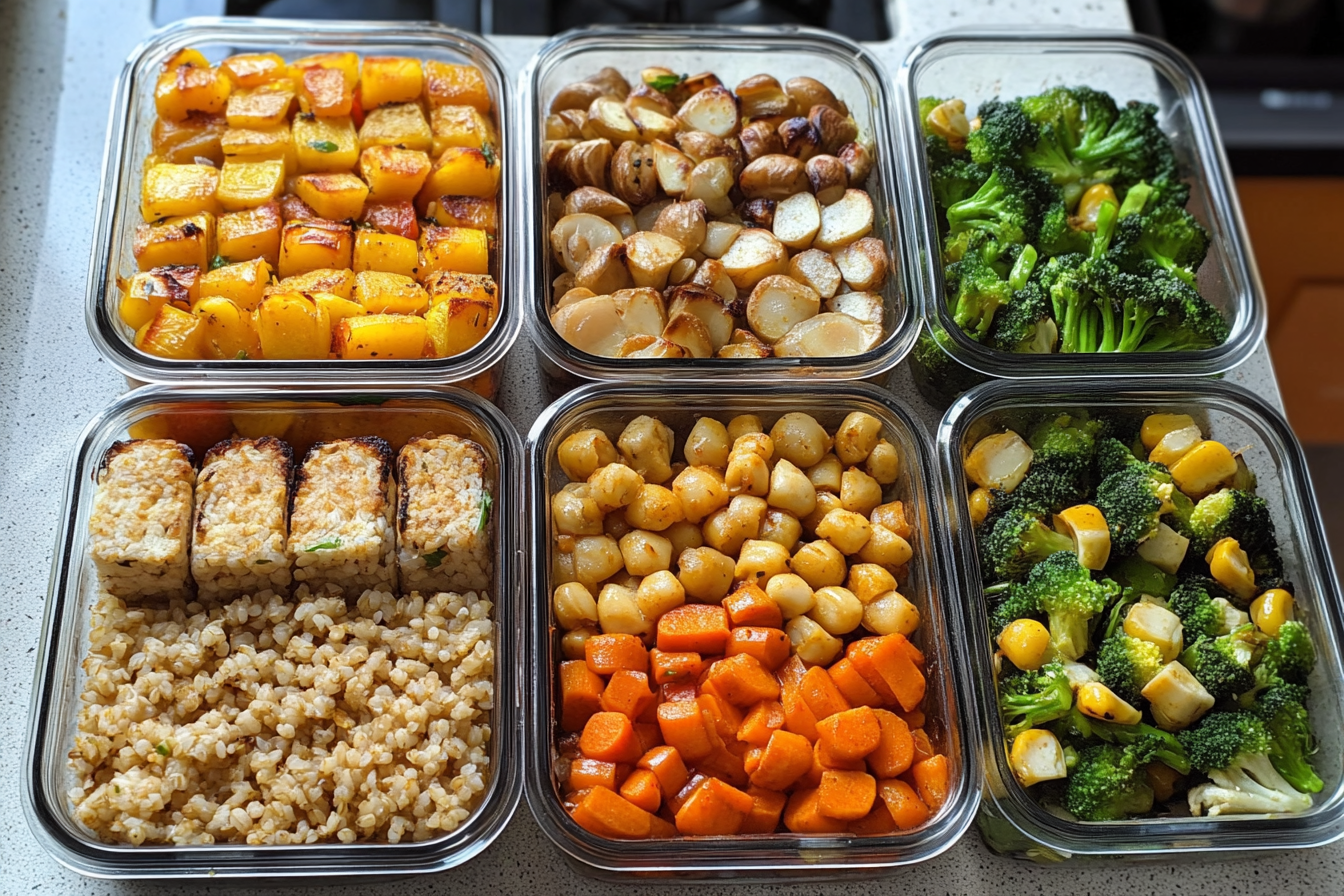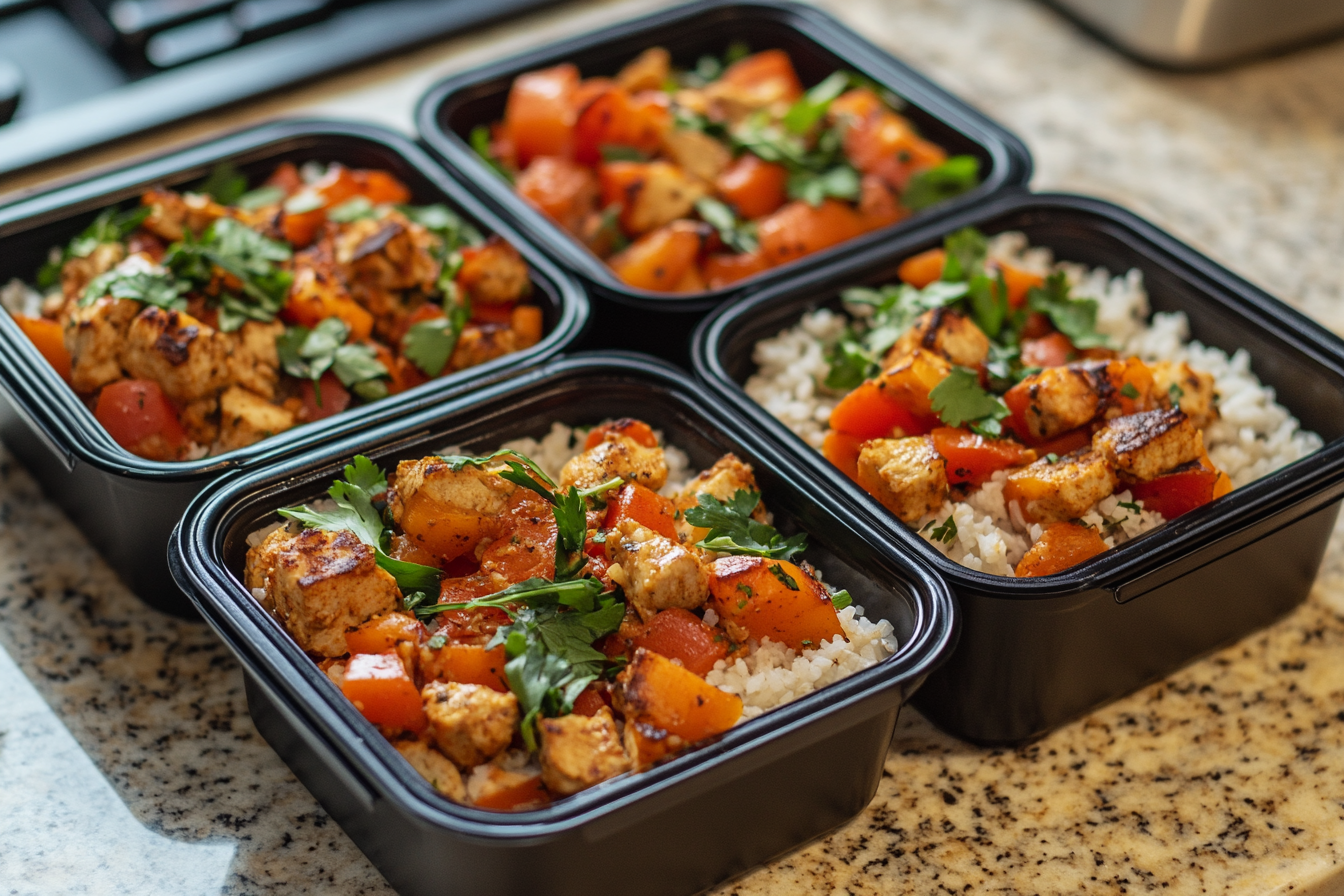Vegan meal prep is more than just a time-saving hack, it’s a lifestyle strategy that can revolutionize the way you eat. By planning and preparing meals ahead of time, you not only ensure that you stick to a nutritious diet, but you also reduce food waste, save money, and minimize the daily stress of figuring out what to eat. Whether you’re a meal prep newbie or a seasoned vegan, this comprehensive guide will provide you with everything you need to succeed.
Why Vegan Meal Prep Is Essential
Eating a plant-based diet offers many health benefits, including improved digestion, lower risk of chronic diseases, and increased energy levels. However, busy lifestyles can make it challenging to prepare balanced meals every day. That’s where vegan meal prep comes in it allows you to stay on track with your dietary goals, even on your busiest days.
The Key Benefits of Vegan Meal Prep
- Consistency: When your meals are prepped and ready, you’re more likely to stick to your dietary goals. Consistency is key to long-term success on any diet.
- Nutritional Control: By preparing meals in advance, you have full control over the ingredients, portion sizes, and nutritional balance. This makes it easier to ensure you’re getting enough protein, fiber, and essential nutrients.
- Financial Savings: Meal prepping helps you plan your grocery shopping more effectively, allowing you to buy in bulk and avoid impulse purchases. The more you plan, the less likely you are to waste food.
- Time Management: Preparing meals ahead of time frees up hours during the week, allowing you to focus on other important tasks or simply relax without worrying about cooking.
Getting Started: What You Need for Vegan Meal Prep
Before you start prepping, it’s important to have the right tools and a clear strategy in place.

Essential Tools for Vegan Meal Prep
- Meal Prep Containers: Invest in airtight, stackable containers that are microwave and dishwasher safe. Glass containers are ideal because they’re durable, reusable, and won’t absorb odors.
- Mason Jars: Perfect for overnight oats, salads, and soups, mason jars help keep ingredients fresh and make it easy to portion your meals.
- Blender or Food Processor: A high-quality blender is essential for making smoothies, sauces, and soups. A food processor can speed up chopping, slicing, and shredding vegetables.
- Sharp Knives and a Cutting Board: Invest in a good set of knives and a large cutting board to make chopping and slicing more efficient.
- Non-Stick Cookware: High-quality non-stick pans make cooking quicker and reduce the need for excessive oil.
Planning Your Vegan Meal Prep
Meal prepping starts with effective planning. Here’s how to structure your prep process:
- Set Your Goals: Determine what you want to achieve with your meal prep. Are you focused on weight loss, increasing protein intake, or simply eating healthier? Your goals will influence the types of recipes you choose.
- Create a Weekly Menu: Plan your meals for the week, ensuring you have a balance of proteins, carbohydrates, and healthy fats. A typical menu might include breakfast, lunch, dinner, and snacks.
- Make a Shopping List: Once your menu is planned, make a detailed shopping list to ensure you have all the ingredients you need. This will save you time and prevent multiple trips to the grocery store.
For additional tips on how to plan your meals and maintain a balanced vegan diet, explore these Pumpkin Banana Loaf recipes, which can easily fit into your weekly prep.
Easy Vegan Meal Prep Recipes for Every Meal
To make your meal prep even easier, here are some simple, nutritious recipes that you can batch cook and enjoy throughout the week.
Breakfast Ideas
- Overnight Oats:
- Ingredients: Rolled oats, chia seeds, almond milk, banana slices, maple syrup, and berries.
- Instructions: Combine oats, chia seeds, and almond milk in a mason jar. Add banana slices and a drizzle of maple syrup. Let it sit overnight in the fridge. In the morning, top with fresh berries and enjoy.
- Variations: Add cacao powder for chocolate oats or peanut butter for a rich and creamy texture.
- Tofu Scramble:
- Ingredients: Firm tofu, nutritional yeast, turmeric, garlic powder, spinach, and cherry tomatoes.
- Instructions: Crumble the tofu in a pan, add spices, and cook until golden. Add spinach and tomatoes, cooking until the veggies are tender. Serve with whole-grain toast or as a filling in a breakfast wrap.
Lunch and Dinner Ideas
- Quinoa and Chickpea Power Bowl:
- Ingredients: Quinoa, chickpeas, avocado, spinach, roasted sweet potatoes, and tahini dressing.
- Instructions: Cook quinoa according to package instructions. Roast sweet potatoes with olive oil and spices. Assemble the bowl with a base of spinach, topped with quinoa, chickpeas, roasted sweet potatoes, and sliced avocado. Drizzle with tahini dressing.
- Meal Prep Tip: Store the dressing separately to keep the ingredients fresh throughout the week.
- Vegan Lentil Soup:
- Ingredients: Lentils, carrots, celery, onion, garlic, vegetable broth, diced tomatoes, and spices.
- Instructions: Sauté onions, garlic, carrots, and celery until softened. Add lentils, diced tomatoes, and broth. Simmer until the lentils are tender. Season with your favorite spices, and store in mason jars for easy reheating.
- Meal Prep Tip: Freeze half the batch for a ready-made meal in future weeks.
Snack Ideas
- Energy Balls:
- Ingredients: Rolled oats, almond butter, dates, cacao powder, and shredded coconut.
- Instructions: Combine all ingredients in a food processor until well-mixed. Roll into balls and refrigerate. These are perfect for an on-the-go snack or post-workout energy boost.
- Hummus and Veggie Packs:
- Ingredients: Homemade hummus, carrot sticks, cucumber slices, and bell pepper strips.
- Instructions: Portion out hummus into small containers and pack with pre-cut veggies. This is an easy, healthy snack that’s full of fiber and nutrients.
For a more indulgent snack or dessert option, try these delicious Earl Grey Cookies that can be easily incorporated into your prep routine.
Advanced Vegan Meal Prep Strategies
Once you’re comfortable with basic meal prep, you can start incorporating more advanced techniques to make your weekly routine even more efficient.
Batch Cooking and Freezing
Batch cooking is a key component of successful meal prep. By making large quantities of food at once, you can save time and ensure you always have healthy meals on hand.
- Best Foods for Batch Cooking: Soups, stews, grain dishes, and casseroles are ideal for batch cooking. These dishes freeze well and can be portioned out easily.
- Freezing Tips: Use freezer-safe containers and label everything with the date and contents. Freeze in individual portions to make reheating quick and convenient.
- Reheating Instructions: Most batch-cooked meals can be reheated in the microwave or on the stovetop. For soups and stews, add a splash of water or broth when reheating to maintain the original texture.
Diversifying Your Meal Plan
One of the biggest challenges with meal prep is avoiding food fatigue. Here are some tips to keep your meals exciting:
- Rotate Recipes: Instead of repeating the same recipes every week, rotate your menu every two weeks. This helps you try new foods while keeping your meals varied.
- Incorporate Seasonal Ingredients: Plan your meals around what’s in season. This not only supports local farmers but also gives your dishes fresh, vibrant flavors.
- Experiment with Different Cuisines: Try incorporating global flavors into your meals, such as Mediterranean, Mexican, or Asian-inspired dishes.
Customizing Your Vegan Meal Prep for Specific Dietary Goals
Not all vegan diets are the same, and meal prep can be tailored to meet specific nutritional needs.
High-Protein Vegan Meal Prep
If your focus is on increasing protein intake, build your meals around high-protein ingredients like lentils, tofu, tempeh, seitan, and beans. For breakfast, consider adding protein powder to your smoothies or oatmeal.
Low-Carb Vegan Meal Prep
For those who are reducing their carbohydrate intake, focus on meals that are rich in leafy greens, cruciferous vegetables, and plant-based proteins. Cauliflower rice, zucchini noodles, and spaghetti squash are excellent low-carb substitutes for grains and pasta.
Gluten-Free Vegan Meal Prep
A gluten-free vegan diet can be challenging, but it’s manageable with careful planning. Opt for naturally gluten-free grains like quinoa, buckwheat, and wild rice. Make sure to check labels for hidden gluten, especially in sauces and pre-packaged foods.
Sustainability and Reducing Waste in Vegan Meal Prep
Sustainability is an important aspect of vegan meal prep, and there are several ways you can make your prep routine more eco-friendly.
Tips for Reducing Food Waste
- Plan Your Portions Carefully: Avoid over-buying by planning realistic portions for each meal. Use apps or charts that guide portion sizes based on the number of servings.
- Use Leftover Ingredients Creatively: Turn vegetable scraps into broth, add leftover grains to soups, or mix random veggies into a stir-fry.
- Compost Food Scraps: If you have a garden, composting is a great way to turn food waste into nutrient-rich soil.
Eco-Friendly Storage Solutions
- Reusable Containers: Glass and silicone containers are better for the environment than single-use plastic.
- Beeswax Wraps: Replace plastic wrap with beeswax wraps, which are reusable and biodegradable.
- Bulk Buying: Purchase grains, beans, and spices in bulk to reduce packaging waste.
Frequently Asked Questions About Vegan Meal Prep
Here are some common questions people have when starting with vegan meal prep:
- How long do prepped meals last in the fridge? Most prepped meals last 4-5 days in the fridge. For longer storage, consider freezing meals.
- Can I meal prep smoothies? Yes, you can prep smoothie packs by combining ingredients in freezer bags and blending them when ready to consume.
- What’s the best way to store prepped meals? Store meals in airtight containers. Glass containers are ideal because they’re easy to clean, durable, and don’t absorb odors.
Conclusion
Vegan meal prep is a powerful tool for anyone looking to maintain a healthy plant-based diet, save time, and stay organized. By planning ahead and preparing meals in bulk, you can ensure that you always have delicious, nutrient-dense meals on hand, no matter how busy your schedule gets. With the tips, strategies, and recipes provided in this guide, you’ll be well on your way to mastering the art of vegan meal prep and enjoying all the benefits that come with it.


